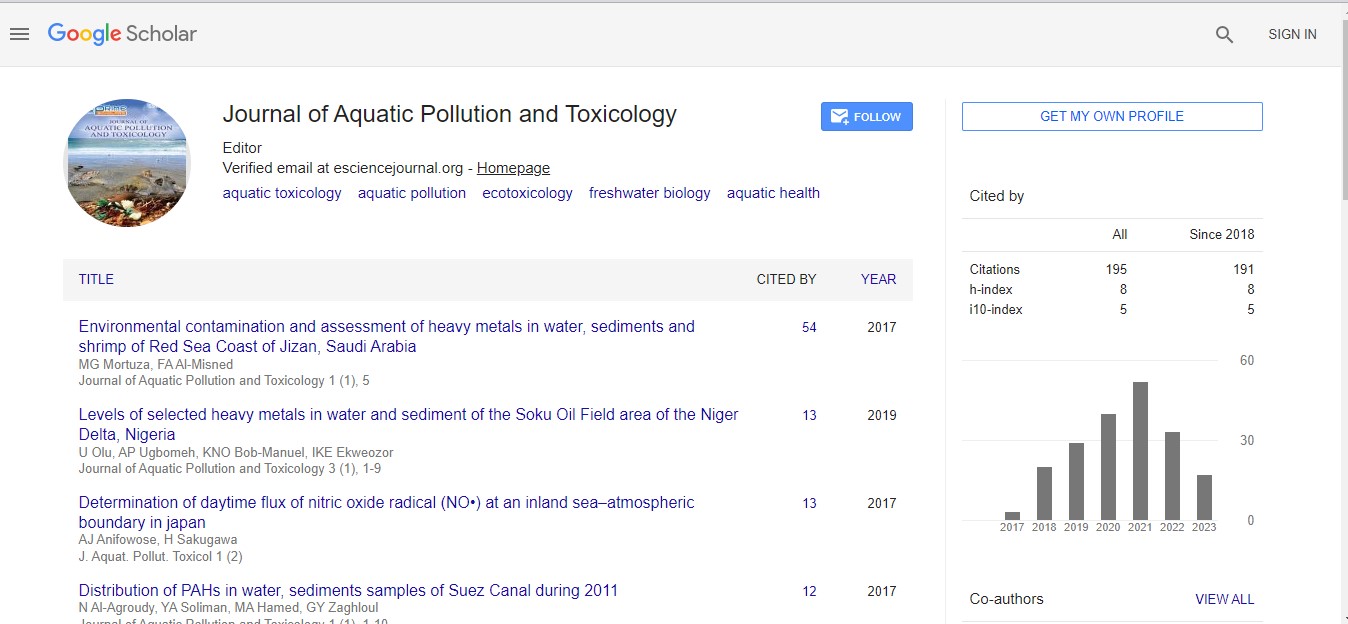Short Communication - (2024) Volume 8, Issue 3
Understanding Wastewater: Challenges and Innovations
Hiroshi Inoue*
Department of Aquatic Science, Ritsumeikan University, Japan
*Correspondence:
Hiroshi Inoue,
Department of Aquatic Science, Ritsumeikan University,
Japan,
Email:
Received: 02-Sep-2024, Manuscript No. IPJAPT-24-21318;
Editor assigned: 04-Sep-2024, Pre QC No. IPJAPT-24-21318 (PQ);
Reviewed: 18-Sep-2024, QC No. IPJAPT-24-21318;
Revised: 23-Sep-2024, Manuscript No. IPJAPT-24-21318 (R);
Published:
30-Sep-2024, DOI: 10.21767/2581-804X-8.3.21
Introduction
Wastewater is an integral yet often overlooked component
of modern infrastructure, crucial to both environmental
health and public safety. Wastewater treatment reduces
environmental pollution. Essentially, wastewater is any
water that has been adversely affected in quality by human
influence, typically through domestic, industrial, or agricultural
activities. This contaminated water necessitates treatment
before it can be safely returned to the environment or
reused. Understanding wastewater’s complexities and the
advancements in its management is vital for sustainable
development and ecological preservation. Wastewater arises
from various sources including households, industries, and
agricultural runoff. Domestic wastewater, also known as
sewage, originates from sinks, showers, toilets, and washing
machines. It contains organic matter such as food particles,
human waste, and chemicals from cleaning products. Industrial
wastewater comes from factories and industrial processes and
may include hazardous substances like heavy metals or toxic
chemicals. Agricultural runoff, which includes fertilizers and
pesticides, can also contribute to wastewater.
Description
Domestic wastewater typically has high levels of organic
matter and nutrients like nitrogen and phosphorus, while
industrial wastewater might include pollutants that are
specific to the type of industry. The treatment of wastewater
generally involves several stages, each designed to remove
specific types of contaminants. The primary treatment stage
focuses on the removal of large solids through screening and
sedimentation. This stage reduces the load on subsequent
treatment processes but does not significantly alter the water’s
chemical composition. Secondary treatment is a biological
process that degrades dissolved organic matter. This is typically
achieved through aerobic digestion, where microorganisms
break down organic pollutants in the presence of oxygen.
Secondary treatment significantly reduces the biochemical
oxygen demand (BOD) and nutrient levels in the water. Tertiary
treatment, the final stage, targets remaining contaminants to
achieve a higher quality of effluent. This can involve advanced
filtration, chemical treatments, or biological processes like
nutrient removal. Tertiary treatment ensures that the treated
water meets stringent environmental standards before being
released into natural water bodies or reused for purposes
such as irrigation or industrial processes. The management of
wastewater presents several challenges. Aging infrastructure
can lead to leaks and inefficiencies, while rapid urbanization and
population growth put additional pressure on existing systems.
Furthermore, emerging contaminants such as pharmaceuticals
and microplastics pose new risks that traditional treatment
methods may not effectively address. In response to these
challenges, significant innovations are underway [1-4].
Conclusion
One promising development is the integration of smart
technologies and sensors into wastewater management
systems. These technologies enable real-time monitoring of
water quality and system performance, allowing for prompt
responses to any issues that arise. Another innovation is the use
of decentralized treatment systems. Instead of relying solely
on large, centralized facilities, smaller, localized systems can
be deployed in rural or underserved areas. These systems can
reduce the need for extensive transportation infrastructure and
offer more tailored solutions for specific types of wastewater.
Additionally, the concept of resource recovery from wastewater
is gaining traction. Techniques such as anaerobic digestion not
only treat wastewater but also produce biogas, which can be
used as a renewable energy source. Wastewater management
is a complex field that intersects with environmental science,
engineering, and public health. Addressing the challenges of
wastewater treatment requires both robust infrastructure
and innovative solutions. As technology advances and new
methods emerge, the goal remains clear to protect water
resources, safeguard human health, and contribute to a
sustainable future.
Acknowledgement
None.
Conflict Of Interest
The author declares there is no conflict of interest in publishing
this article.
References
- Finlay BJ (2002) Global dispersal of free-living microbial eukaryote species. Science 296(5570): 1061-1063.
[Crossref] [Google Scholar]
- Grover JP, Chrzanowski TH (2004) Limiting resources, disturbance, and diversity in phytoplankton communities. Ecol Monogr 74(3): 533-551.
[Crossref] [Google Scholar]
- Kishida T (2021) Olfaction of aquatic amniotes. Cell Tissue Res 383(1):353-365.
[Crossref] [Google Scholar] [PubMed]
- Gamage NT G, Miyashita R, Takahashi K, Asakawa S, Senevirathna JDM, et al. (2022) Proteomic applications in aquatic environment studies. Proteomes 10(3):32.
[Crossref] [Google Scholar] [PubMed]
Citation: Inoue H (2024) Understanding Wastewater: Challenges and Innovations. J Aquat Pollut Toxicol. 8:21.
Copyright: © 2024 Inoue H. This is an open-access article distributed under the terms of the Creative Commons Attribution License, which permits unrestricted use, distribution, and reproduction in any medium, provided the original author and source are credited.

